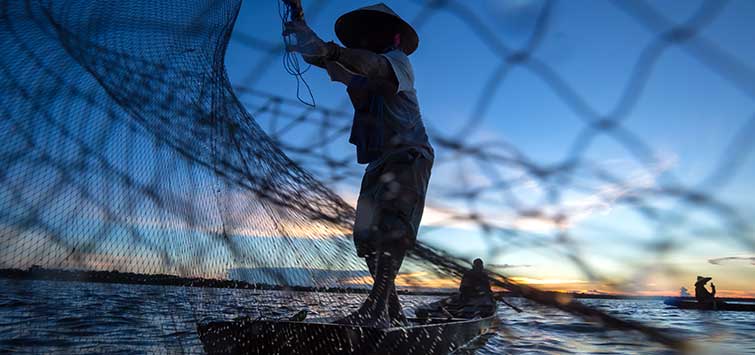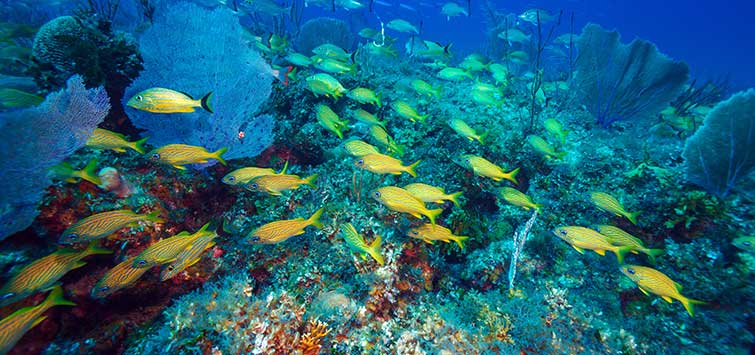Net-Only Fish Collection by Indonesian Collectors
Author: Ron Lilley
Many hobbyists are unaware that cyanide and other poisons may still be used by fish collectors to catch marine ornamentals. Most of the fishes caught using cyanide die well before they reach the retailer. Others do make it as far as a hobbyist’s aquarium, only to die a few months later because of internal damage caused by the cyanide.
Net-Only Technique Basics
The use of net-only collection techniques is an eco-friendly and sustainable alternative to the use of cyanide. For years, collectors have been using cyanide fishing as an easy and fast means to harvest marine ornamentals. Cyanide damages reefs and causes elevated levels of fish mortality.
Through training workshops and recruitment of skilled net collectors, the Marine Aquarium Council (MAC) has demonstrated that all species can be caught responsibly, sustainably, and in a timely manner. With improved handling techniques, fish are less stressed, and lower mortality rates and healthier fish are being observed. This significantly improves the quality of fish, resulting in economic benefits for the collectors from their fishing activity.
MAC has been helping to train Indonesian fish-collecting groups in adopting net-only capture methods for more than five years. While collectors are initially skeptical that fish can be caught in other ways besides using cyanide, they become convinced when experienced local collectors and trainers show them that it is possible. Using only nets, a collector can catch the same amount of fish without the high reject rates, mortalities, and reef damage associated with cyanide use.
Hand-Made and Manufactured Nets
Since manufactured netting is expensive and not available in most local shops, many Indonesian collectors must make their nets by hand. Nets are woven using a needle and strong cotton, or sometimes nylon thread. A scoop net can be woven in a day, but a full-length barrier net can take up to a month to weave. Experienced weavers can sell the nets they make to other collectors. Nets are woven between collecting sessions, on the boat, in the village, or when the sea is too rough for collecting. Weaving is mostly done in the daylight, especially where there is no electricity.
Manufactured Netting
If they have the funds, and can find a source, collectors will often buy manufactured netting. Mosquito netting is sometimes available, but it is expensive, weak, and the mesh is too small.
Some of the best factory-produced netting is made from knotted, single-filament nylon. It is lighter than handmade netting, and nets of various types are quicker to make. With few repairs, this type of net can last for up to six months.
High-quality manufactured netting can be imported, but when combined with freight charges, the cost is generally prohibitive for local fish collectors. The manufacturers only sell in bulk, so several thousand meters need to be purchased each time. The best and most affordable netting comes from Taiwan, costing only a few cents per meter.
Making and Repairing Nets
Between fishing trips, collectors take the opportunity to repair their nets and sew new ones. They also discuss types of netting and capture techniques. They often debate about the best mesh size for specific species, as well as the suitable color of netting to avoid scaring the fish. Over time, collectors have developed a preference for brown- and green-colored nets for deep fishing. They also often discuss the way fish deflect off of netting that is too rigid, or how they become entangled in too large or too soft of a meshing. Collectors are fully aware that rough netting can damage the scales of fish. In the end they all dream about the “perfect” net, which will enable them to collect marine ornamentals in the most responsible way and continue to improve their livelihood.
Various Types of Nets
Many types of nets have long been used by fish collectors to harvest marine ornamentals in Indonesia. Barrier nets and scoop nets are the two most commonly used.
Barrier Nets
Barrier nets are mostly handmade. They consist of a large, rectangular piece of netting (1 to 2 meters in height, 2 to 6 meters in length) and are made of mesh roughly ½ cm in size (smaller than those used for food fish). If the only netting available is one meter wide, than two lengths can be sewn together to make a deeper net. Small rectangular floats are cut from old rubber sandals and tied at intervals along the top of the netting. Lead fishing weights are attached along the bottom edge.
The finished net is bunched together and folded to make it more portable and taken with the diver into the sea. When using a barrier net, collectors often work in pairs. Once underwater, they target a fish and carefully unfold the net, setting it in a semicircle some distance upstream from the fish to be caught, avoiding any contact with corals.
When opened up, the top edge of the net floats upward, while the weighted bottom edge sits tidily on the seabed. The top of the netting drifts with the current, so the net leans at an angle toward the collectors.
Scoop Nets
The other most commonly used net is the scoop net. The collector uses it to drive the target fish toward the barrier net. It allows fish to be trapped and transferred to a bucket or a plastic bag, or taken straight to the surface to be stored in the floating basket.
Many species, from small damselfishes (Pomacentrids) to the larger angelfishes (Pomacanthids), are caught using barrier nets. Collectors sometimes take two or even three sizes of barrier nets with them, depending on the type of fish to be caught. Trying to deal with three nets at once is very difficult! Many collectors would like to be able to buy strong, all-purpose barrier nets made of durable, soft netting with a relatively small mesh size. However, these are not available in Indonesia.
Alternative Nets
While barrier nets and scoop nets are the types of nets most widely used to collect marine ornamental organisms, collectors also employ other nets, traps, and devices. These tools are exploited for more specific fish species, and may require special skills for which only a few collectors have been trained. These alternative nets include, among others, the “sausage” net and the “butterfly” net.
Sausage Nets
The sausage net represents a tiny elongated version of the scoop net. The opening of its hoop is only 5 cm across, and the net bag is about 15 to 20 cm long. Fishers use it to collect marine ornamentals living in burrows, such as gobies. Once a fish is seen retreating into its burrow, the hoop of the net is placed over the hole, and the fish is teased out into the net. This is accomplished by poking a length of stiff nylon, which is attached to the handle, into the burrow.
Butterfly Nets
The butterfly net, which is also called a scissor net (“saplad” in the Philippines), is named after the shape of a resting butterfly’s wings, created when the net is folded upwards. Originally used extensively in the Philippines, it is now becoming increasingly popular among Indonesian collectors. It consists of a piece of netting about 1.5 meters square, which is tied to two sticks along opposite sides. Weights are also attached along the leading edge. When fishing, the collector swims, holding the net handles in front of him, and carefully maneuvers it under the targeted fish. He then brings the two sticks together, closing the net to catch the fish.
The butterfly net is more maneuverable than the barrier net, and it’s also much larger than a scoop net. A “tickler rod” can be attached to one of the sticks at the front, to tease fish out of their hiding places. Butterfly nets can be of various lengths and mesh sizes, depending on the species being targeted.
MAC Training and Advocacy
Fishing activities remain a community business. Indeed, collecting groups generally work in isolation for many years. There is little transfer of techniques, even between neighboring groups. As part of its training programs, MAC employs collectors from particular areas to teach other communities new techniques, ensuring that the methods taught minimize damage to the fish during capture, handling, and transport.
Due to the unavailability of soft netting of various mesh sizes as discussed, collectors often have no choice but to weave their own netting. The coarseness of this homemade netting can damage a collected fish. This is the reason MAC, along with other organizations and fishing communities, hope that responsible and caring industry operators and hobbyists can assist fishers in obtaining better-quality soft netting.
For more detailed information about MAC programs, please contact MAC at info@aquariumcouncil.org or visit its website at www.aquariumcouncil.org.
See the full article on TFH Digital http://www.tfhdigital.com/tfh/200712/#pg76

.png?h=595&iar=0&w=2781&hash=5FD5E69473BCC22199FBFA2FB71B6033)



